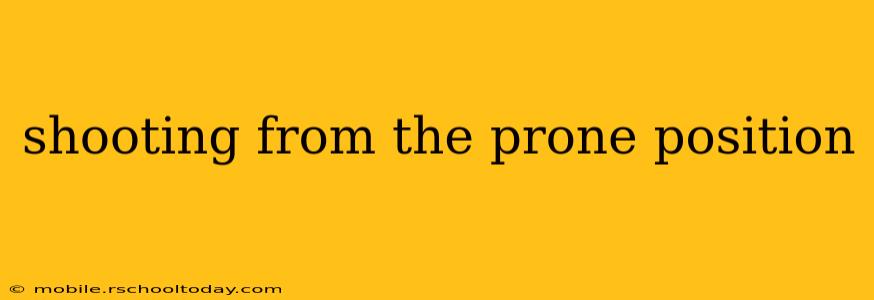The prone position, lying flat on your stomach, offers unparalleled stability for shooting, making it a favorite among precision shooters, hunters, and military personnel. While seemingly simple, mastering the prone position requires understanding several key elements—from proper body positioning to equipment selection. This comprehensive guide will equip you with the knowledge and techniques to significantly improve your accuracy and consistency from this fundamental shooting position.
Why Choose the Prone Position?
The prone position's superiority stems from its inherent stability. By distributing your weight evenly across your body, you minimize movement and recoil impact, resulting in:
- Increased Accuracy: The stable platform allows for finer control over your weapon, leading to tighter shot groups and improved accuracy at longer ranges.
- Reduced Recoil: The earth acts as a natural recoil buffer, absorbing a significant portion of the recoil energy and reducing muzzle rise.
- Improved Sight Picture: Your body's natural alignment provides a more consistent and stable sight picture, reducing human error.
- Concealment and Camouflage: The prone position offers natural concealment, blending you into the terrain and making you a less visible target.
Essential Elements of the Prone Position: A Step-by-Step Guide
Achieving optimal stability and accuracy in the prone position involves attention to detail. Follow these steps for optimal setup:
1. Finding the Right Support
- Ground Selection: Choose a stable, level surface free from rocks, debris, or uneven terrain. A shooting mat or pad significantly enhances comfort and stability.
- Body Position: Lie flat on your stomach with your feet slightly apart for balance. Your elbows should be positioned comfortably, offering support for your weapon. Avoid straining or discomfort.
2. Weapon Support
- Using a Bipod (Recommended): A bipod provides unparalleled stability, especially at longer ranges. Ensure the bipod is properly adjusted to your height and terrain.
- Improvised Support: In the absence of a bipod, utilize a shooting bag, rolled-up clothing, or even a sturdy rock to support your fore-end and provide a stable platform.
3. Body Alignment and Breathing
- Natural Breathing: Breathe naturally and slowly; hold your breath only during the shot.
- Proper Alignment: Align your body for optimal stability. Maintain a straight line of sight, ensuring your weapon is aligned with your dominant eye. Avoid twisting your body or shoulders.
4. Trigger Control
- Smooth Squeeze: Apply gradual, controlled pressure on the trigger. Avoid jerking or anticipating the shot.
- Follow Through: After the shot, maintain your sight picture and body position.
Advanced Techniques for Prone Shooting
Once you've mastered the fundamentals, consider these advanced techniques to further refine your skills:
Adjusting for Wind: Understanding wind conditions is crucial for accurate long-range shooting. Practice wind reading and make appropriate adjustments to your aim.
Using a Rear Bag: Adding a rear bag for buttstock support provides further stability and helps control recoil.
Practicing Different Shooting Styles: Experiment with variations in prone position, such as the high prone (upper body slightly elevated) or low prone (body closer to the ground), to find what works best for you and your weapon.
Conclusion: Practice Makes Perfect
Mastering the prone position is a journey that requires consistent practice and attention to detail. By focusing on proper body alignment, weapon support, and breathing techniques, you can significantly enhance your shooting accuracy, consistency, and overall performance. Remember, regular practice is key to refining your skills and becoming proficient in this essential shooting position.
